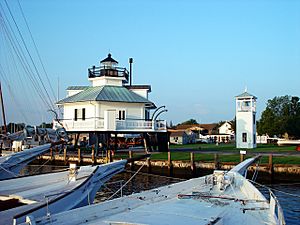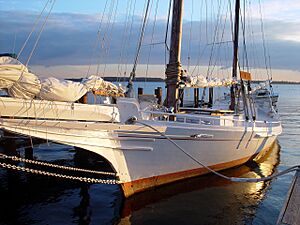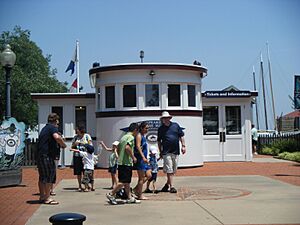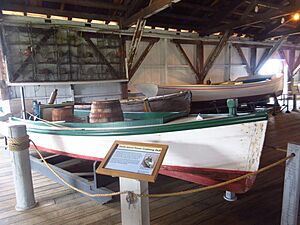Chesapeake Bay Maritime Museum facts for kids
The Chesapeake Bay Maritime Museum is a fun and interactive museum in St. Michaels, Maryland. It's located right on the beautiful Chesapeake Bay in the United States. This museum is like a treasure chest filled with amazing things from the Bay's past.
You can see old tools, cool exhibits, and many different kinds of boats here. The museum started in 1965 on a spot called Navy Point. This area used to be busy with seafood businesses and work boats. Today, the museum covers about 18 acres. It has the world's largest collection of Chesapeake Bay boats. There are also 35 buildings with hands-on exhibits. The museum also offers cool learning programs all year long.
Contents
History of the Museum
The Chesapeake Bay Maritime Museum first opened its doors in 1965. It began as a project of the Historical Society of Talbot County. They bought three waterfront houses along St. Michaels Harbor. Soon, the museum started collecting historic boats. These included the oyster sloop J. T. Leonard in 1966. The famous log-bottom bugeye Edna E. Lockwood joined the collection in 1967.
More land became available as seafood businesses closed down. The museum bought land from a former crab and oyster packing house in 1966. By the end of that year, the Hooper Strait Lighthouse was moved to the museum. It was saved from being torn down. The lighthouse opened to visitors in May 1967. By 1971, the museum owned all the land on Navy Point.
In 1968, the museum became its own independent organization. It hired its first full-time director, R. J. "Jim" Holt, in 1971. He helped the museum grow a lot. In 1976, the museum got more land by Fogg's Cove. In 1978, it was officially recognized by the American Association of Museums.
Sadly, the J. T. Leonard sank in 1974 because it was too old. This showed the museum needed better ways to care for its floating boats. So, they built a traditional boat repair area in 1974. A boat shop was added in 1977. The Edna E. Lockwood was carefully rebuilt from her original nine logs. She was relaunched in 1979.
New buildings were also added for exhibits. These included the Waterfowling on the Chesapeake building (1975). The Bay of the Chesapeake building opened in 1980. The Steamboat building was added in 1990. In the 1980s, the museum also moved several small historic buildings to its campus. One important one was the Mitchell House. It was the former home of Eliza Bailey Mitchell, who was the sister of Frederick Douglass. By the time Jim Holt retired in 1987, the museum had grown to 17 acres. It had many historic structures and exhibit buildings.
John R. Valliant took over as director after Jim Holt. He helped the museum grow even more. A library, an Oystering Building, and an At Play on the Bay building were added. These were part of a big fundraising effort. During his time, the museum also started many new programs. These included boatyard apprenticeships and "Apprentice for a Day" classes. The Academy for Lifelong Learning was also created. It offers classes taught by other learners. Valliant also greatly expanded the museum's collections. They bought old sailmaking tools in 1997. They also acquired many artworks by marine artist Louis Feuchter. A large collection of maritime objects and photos from Robert H. Burgess was added in 2006.
Stuart Parnes became director in 2006. He helped turn the waterfront into a natural "living shoreline." Langley Shook followed him in 2009. He helped the museum's finances after an economic downturn. He also oversaw a major restoration of the 1955 skipjack Rosie Parks. The historic 1920 buy boat Winnie Estelle was also acquired. It replaced the replica Mister Jim for taking visitors on tours of the Miles River.
Kristen Greenaway became director in 2014. She expanded the museum's special exhibits. One exhibit, "A Broad Reach: Fifty Years of Collecting," celebrated the museum's 50th anniversary in 2015. She also worked to fix up museum buildings. This included work on the Hooper Strait Lighthouse. Brickwork on Dodson House was also repaired. This was one of the museum's first three buildings. It is now used for offices. She also oversaw the second major restoration of the bugeye Edna E. Lockwood. This project began in 2016.
Museum Exhibits
The Chesapeake Bay Maritime Museum shares the stories of the Bay. You can learn about its geological past, its economy, and the people who lived there. Visitors can see over 100 boats and boat models. There are also many artworks, including watercolors, decoys, and ship signs. You can also find other historical Bay artifacts.
Larger exhibits include Tilghman Island’s original Knapps Narrows drawbridge. The 1879 Hooper Strait Chesapeake screw-pile lighthouse is also a highlight. At the museum’s working boatyard, you can even try building a wooden skiff. This is part of the "Apprentice for a Day" program.
One fun, interactive exhibit is Waterman's Wharf. Here, you can pretend to harvest seafood. You can pull an eel or crab pot out of Fogg Cove's waters. Another exhibit, Oystering on the Chesapeake, takes you onto a working waterman's boat. It shows how the oyster industry shaped the region's culture and history.
The Floating Fleet is one of the most popular exhibits. This collection of boats is docked at Navy Point. It includes the Edna E. Lockwood. She is a National Historic Landmark. She is also the last sailing log-bottom bugeye left. The museum helps keep the Chesapeake Bay log canoe racing alive. They preserve and sail the Edmee S.. This is the museum’s own log racing canoe. Museum staff race it on summer weekends.
The dredgeboat Old Point was built from seven logs in 1909. It used to carry fresh fish in winter. It also carried oysters in the fall and clams in the summer. Today, kids can have a hands-on "waterman" experience on board. The Winnie Estelle, the museum's historic buy boat, takes visitors on tours of the Bay. These tours happen throughout summer weekends. Through all these exhibits, the museum helps everyone experience the history and culture of the Chesapeake Bay.
During the COVID-19 pandemic, the museum created a digital exhibit. This allowed people to visit from home. Island Life: Changing Cultures, Changing Shorelines is a photography exhibit. It shows how climate change affects the Chesapeake Bay. It explores fast climate change, shore erosion, and communities moving because of the environment.
Learning and Outreach Programs
The Chesapeake Bay Maritime Museum (CBMM) offers field trips for students. These trips are for kids from preschool to college. They focus on history, geography, and the Bay's environment. A bus scholarship program helps schools pay for transportation. The Lighthouse Overnight Program lets children experience life as a mariner. They even stand watch overnight!
The museum also has programs just for kids. These include the Sea Squirts Summer Camp. There are also hands-on games, crafts, and storytelling all year. For adults, the museum offers a Lecture Series and guided tours. The Academy for Lifelong Learning provides courses for continued learning. In addition to programs, the museum has a large library. It holds 10,800 books, ship plans, and old writings.
Working Boatyard
The museum has a real working boatyard. Here, they restore old boats and teach people. Visitors can watch as commercial skipjacks are restored. They also see how the museum's own floating fleet is kept in good shape. The "Apprentice for a Day" program lets visitors help build a wooden skiff. Boatyard staff members guide them through the process.
See also
- List of maritime museums in the United States
- List of museum ships





